

F-14 Tomcat:
History
Specifications
Bureau Numbers
Walk-Around
Squadrons
Photos
Books
Memorabilia
Other Topics:
Grumman A/C
EXTRA 400
A/C Photos
Links
Guestbook
Credits
The Author


|
F-14 Combat Records

"Bad News for the Bad Guys: The F-14 is still in the game!"

History of F-14s in Combat:
Vietnam War
The F-14 came to late for the Vietnam war and only one deployment about USS Enterprise (CVAN-65) with CVW-14 was made from 17 September 1974 to 20 May 1975. Even though VF-1 and VF-2 Tomcats flew combat air patrols over South Vietnam as part of Operation Frequent Wind, F-14s didn't score any MiG kill. The following squadrons belonged to Carrier Air Wing 14:
|
VF-1 |
F-14A |
|
VF-2 |
F-14A |
|
VA-27 |
A-7E |
|
VA-97 |
A-7E |
|
VA-196 |
A-6A, KA-6D |
|
VAQ-137 |
EA-6B |
|
HS-2 |
SH-3D |
|
VAW-113 |
E-2B |
|
RVAH-12 |
RA-5C |
|
VQ-l Det 65 |
EA-3B |
On 29 April 1975, Commander Task Force 76 received the order to execute Operation Frequent
Wind, the evacuation of U.S. personnel and Vietnamese who might suffer as a result of their past service to the allied effort. Later that day, many evacuees had been cleared from the U.S. Defense Attache Office and the U.S. Embassy. This aerial exodus was paralleled by an outgoing tide of junks, sampans, and small craft of all types bearing a large number of the fleeing population. On the afternoon of 30 April, Task Force 76 moved away from the coast. This ended the U.S. Navy's role in the 25-year American effort to aid the Republic of Vietnam in its fight for survival.

Top of the page
Soviet bomber escort
 There was an ever lasting game in the skies over this world's oceans ...
the game was called "Catch that bomber!" Since the F-14's primary mission was to defend
the fleet from attacking Soviet long-range bombers with air-launched anti-ship missiles,
the nature of the game called for the Tomcat crew to train ... and which training is better than
the real thing? Whenever Soviet bombers or fighters closed in on the carrier battle group,
F-14s were there to "welcome" them according to the rules of engagement. The goal was
not to shoot the "enemy" down, but to escort him away from the carrier and to take a
look at the weapons they carry.
There was an ever lasting game in the skies over this world's oceans ...
the game was called "Catch that bomber!" Since the F-14's primary mission was to defend
the fleet from attacking Soviet long-range bombers with air-launched anti-ship missiles,
the nature of the game called for the Tomcat crew to train ... and which training is better than
the real thing? Whenever Soviet bombers or fighters closed in on the carrier battle group,
F-14s were there to "welcome" them according to the rules of engagement. The goal was
not to shoot the "enemy" down, but to escort him away from the carrier and to take a
look at the weapons they carry.

Top of the page
Libya I: VF-41 Black Aces F-14As shoot down two Libyan Su-22 Fitter-Js
in 1981
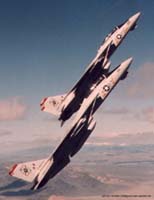
  Moammar Gadhafi, leader of Libya, extended the territorial claims over the Medirannean Sea
to twelve nautical miles instead of the international accepted 2 miles. Playing the role of the
"World Wide Police Force" the US started a challenge against the Libyan leaders'
territorial policy: US aircraft carrier battle groups exercised close to the Libyan twelve mile
zone while US Navy fighters often entered the Libyan "territorial waters". Often
US Navy aircraft were tracked by Libyan radar and Libyan fighter aircraft were launched
against US fighter aircraft, heading in their direction and turning away before coming into too
short range. But sometimes it came to air combat maneuvering missions between Libyan and US Navy
aircraft. The morning of 19 August 1981 began for two patrolling VF-41 F-14As just the same way:
Fast Eagle 102 and Fast Eagle 107 were flying Combat Air Patrol
(CAP) mission for USS Nimitz (CVN-68) aircraft conducting a missile exercise. Moammar Gadhafi, leader of Libya, extended the territorial claims over the Medirannean Sea
to twelve nautical miles instead of the international accepted 2 miles. Playing the role of the
"World Wide Police Force" the US started a challenge against the Libyan leaders'
territorial policy: US aircraft carrier battle groups exercised close to the Libyan twelve mile
zone while US Navy fighters often entered the Libyan "territorial waters". Often
US Navy aircraft were tracked by Libyan radar and Libyan fighter aircraft were launched
against US fighter aircraft, heading in their direction and turning away before coming into too
short range. But sometimes it came to air combat maneuvering missions between Libyan and US Navy
aircraft. The morning of 19 August 1981 began for two patrolling VF-41 F-14As just the same way:
Fast Eagle 102 and Fast Eagle 107 were flying Combat Air Patrol
(CAP) mission for USS Nimitz (CVN-68) aircraft conducting a missile exercise.
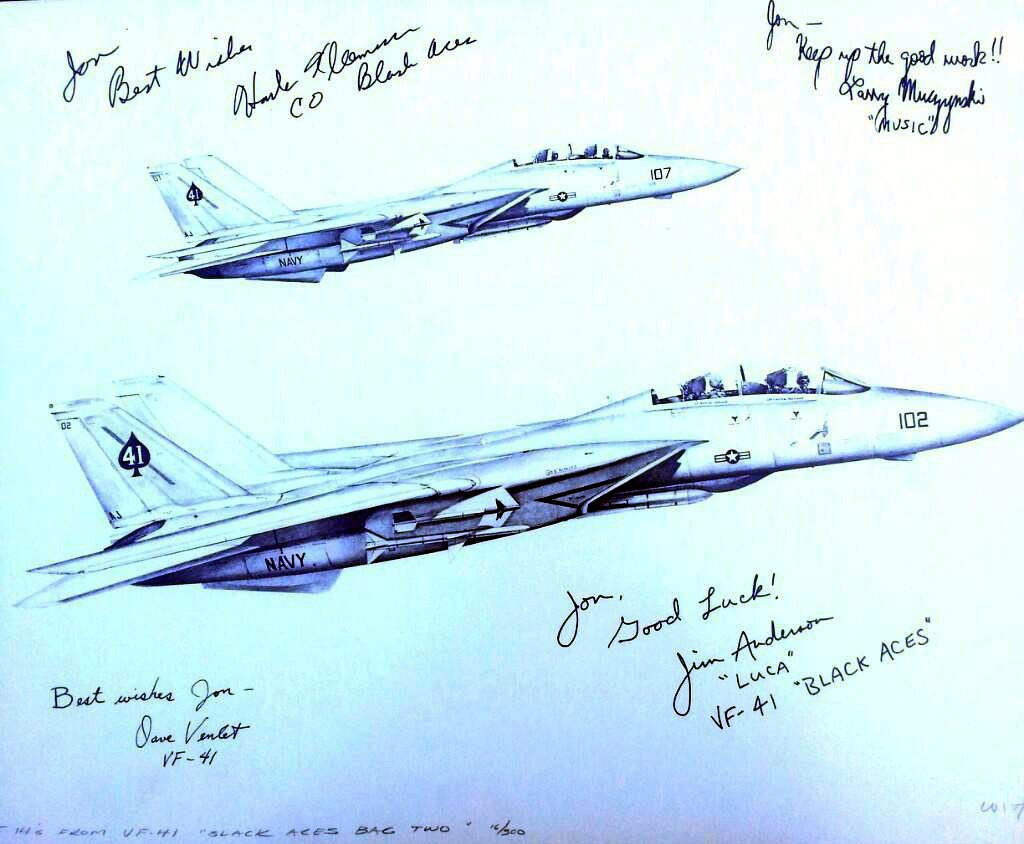 A patrolling E-2A Hawkeye made radar contact with two Libyan Sukhoi Su-22 Fitters which
had taken off from the former Wheelus Air Force Base near Tripoli and were now heading towards
the VF-41 F-14s. As the Fitters were closing in on the Tomcats, the lead Su-22 pilot fired
an AA-2 Atoll air-to-air missile at the F-14s. The missile failed, the Su-22s were declaired
hostile and the Tomcats were cleared to engage. The lead F-14 went for the Fitter wingman
while the other went for the Su-22 leader. Soon thereafter, when the Su-22 turned clear of the
sun of the lead F-14 pilot got a lock-on with an AIM-9 Sidewinder missile and fired, hitting the Su-22's
tailpipe. The Libyan pilot ejected successfully from his burning Fitter. Meanwhile, the second F-14 fired on his lead Fitter at very close range an AIM-9 air-to-air missile and
destroyed the Su-22. The F-14 and its crew had proven itself superior to the Su-22s.
A patrolling E-2A Hawkeye made radar contact with two Libyan Sukhoi Su-22 Fitters which
had taken off from the former Wheelus Air Force Base near Tripoli and were now heading towards
the VF-41 F-14s. As the Fitters were closing in on the Tomcats, the lead Su-22 pilot fired
an AA-2 Atoll air-to-air missile at the F-14s. The missile failed, the Su-22s were declaired
hostile and the Tomcats were cleared to engage. The lead F-14 went for the Fitter wingman
while the other went for the Su-22 leader. Soon thereafter, when the Su-22 turned clear of the
sun of the lead F-14 pilot got a lock-on with an AIM-9 Sidewinder missile and fired, hitting the Su-22's
tailpipe. The Libyan pilot ejected successfully from his burning Fitter. Meanwhile, the second F-14 fired on his lead Fitter at very close range an AIM-9 air-to-air missile and
destroyed the Su-22. The F-14 and its crew had proven itself superior to the Su-22s.
"Navy Two, Libya Zero"
Signed artwork via Jon Morrison

Top of the page
Libya II: VF-32 Swordsmen kill two Libyan MiG-23 Floggers
in 1989
  The day is January 4, 1989. The airspace close to the Libyan coast. Two VF-32 F-14As
from USS John F. Kennedy (CV-67) fly a mission as Combat Air Patrol when a pair of Libyan
Mikoyan-Gurevich MiG-23 Floggers were detected. The MiG-23s had taken off from Al Bumbaw
Airfield near Tobruk and they continued their flight towards
the US fighters, even though the F-14s radar had locked on the bogeys. It's a common procedure
under such circumstances to lock the powerful AWG-9 radar on the incoming Libyan fighters, to
give them the possibility to turn around and head back home. Usually this procedure was
impressive enough to drive
the Libyans back since the radar warning tone resulting from an armed F-14's radar was fearsome
enough. But this time it did not work. For the second time US Navy F-14s were engaged by Libyan
fighter aircraft under hostile conditions. During the 8 minutes engagement, the MiGs kept turning
in on the Tomcats to maintain a firing solution for their Soviet built air-to-air missiles. As
later examination of F-14 still photography resolved, the MiG-23s were armed with AA-7 Apex
missiles. After several evasive maneuvers by the Tomcats and aggressive maneuvers by the
Floggers, the incoming pair of MiG-23s were declared hostile and the F-14 crews were
cleared to engage. The crew of the lead F-14A, AC202 (BuNo. 159437) fired an unsuccessful AIM-7 Sparrow missile,
while the second F-14As, AC207 (BuNo. 159610) AIM-7 found its target and destroyed one MiG-23. Thereafter, the
lead F-14 closed in on the remaining MiG-23 and launched an AIM-9 Sidewinder heat-seaking missile.
The missile exploded in the tailpipe of the fleeing Flogger. The pilot of this MiG-23 also
managed to eject from his destroyed aircraft. Both pilots were seen with good chutes. After this
engagement, the victorious Tomcats headed north for the carrier.
"Navy Four, Libya Zero" The day is January 4, 1989. The airspace close to the Libyan coast. Two VF-32 F-14As
from USS John F. Kennedy (CV-67) fly a mission as Combat Air Patrol when a pair of Libyan
Mikoyan-Gurevich MiG-23 Floggers were detected. The MiG-23s had taken off from Al Bumbaw
Airfield near Tobruk and they continued their flight towards
the US fighters, even though the F-14s radar had locked on the bogeys. It's a common procedure
under such circumstances to lock the powerful AWG-9 radar on the incoming Libyan fighters, to
give them the possibility to turn around and head back home. Usually this procedure was
impressive enough to drive
the Libyans back since the radar warning tone resulting from an armed F-14's radar was fearsome
enough. But this time it did not work. For the second time US Navy F-14s were engaged by Libyan
fighter aircraft under hostile conditions. During the 8 minutes engagement, the MiGs kept turning
in on the Tomcats to maintain a firing solution for their Soviet built air-to-air missiles. As
later examination of F-14 still photography resolved, the MiG-23s were armed with AA-7 Apex
missiles. After several evasive maneuvers by the Tomcats and aggressive maneuvers by the
Floggers, the incoming pair of MiG-23s were declared hostile and the F-14 crews were
cleared to engage. The crew of the lead F-14A, AC202 (BuNo. 159437) fired an unsuccessful AIM-7 Sparrow missile,
while the second F-14As, AC207 (BuNo. 159610) AIM-7 found its target and destroyed one MiG-23. Thereafter, the
lead F-14 closed in on the remaining MiG-23 and launched an AIM-9 Sidewinder heat-seaking missile.
The missile exploded in the tailpipe of the fleeing Flogger. The pilot of this MiG-23 also
managed to eject from his destroyed aircraft. Both pilots were seen with good chutes. After this
engagement, the victorious Tomcats headed north for the carrier.
"Navy Four, Libya Zero"

Top of the page
Lebanon: VF-11 and VF-31 under fire from Syrian SAMs/AAA and engaged in MiGs
in 1983
In 1983 a multi-national peacekeeping force - including some 800 U.S. Marines - did
their duty in Lebanon, a country shaken by civil war. In late 1983 the peacekeeping force was
threatened by both Lebanese military groups and Syrian forces, resulting in combat mission by
aircraft from CVW-3 aboard USS John F. Kennedy. During these missions, VF-11 and VF-31 F-14A were
under fire from Syrian Surface-to-Air missiles (SAM) and Anti-Aircraft-Artillery (AAA). VF-11 even engaged MiGs over Lebanon. One of the aircrews: "While assigned to VF-11, I engaged eight MiGs over Lebanon.
I was the CAP for this mission and flew 3,000 feet above the TARPS F-14 on the
run over Lebanon. My section engaged 4 MiGs. I locked on and prepared to
shoot. Four MiGs did a split S and ran for Syria. Four more MiGs came in to
shoot us but blew through without engaging." None of
the F-14s were losts or damaged, but the Syrians' aggressive action resulted in the National
Command Authority ordering air strikes against Syrian positions near Hammana. During the attacks,
two U.S. Navy aircraft were shot down, one A-7 and one A-6. The A-6 pilot was killed, the B/N taken
prisoner (and released a few weeks later) and the A-7 pilot ejected safely and was recovered by
friendly forces.

Top of the page
The 1985 Achille Lauro affair
 In 1985 the Italian cruise liner Achille Lauro was hijacked by terrorists from the
Palestine Liberation Organisation (PLO) in an attempt to free political prisoners and terrorists
by putting pressure on the Israeli government. During the hijacking of the cruise liner, the
terrorists murdered the American Leon Klinghoffer. Therefore, after the end of the hijacking,
the US government decided to get hold of the terrorists. US intelligence uncovered the plans
of the PLO terrorists and then US President Ronald Reagan ordered the 6th Fleet in the
Mediterranean Sea to take action against the flight of the terrorists from Egypt to Libya.
In 1985 the Italian cruise liner Achille Lauro was hijacked by terrorists from the
Palestine Liberation Organisation (PLO) in an attempt to free political prisoners and terrorists
by putting pressure on the Israeli government. During the hijacking of the cruise liner, the
terrorists murdered the American Leon Klinghoffer. Therefore, after the end of the hijacking,
the US government decided to get hold of the terrorists. US intelligence uncovered the plans
of the PLO terrorists and then US President Ronald Reagan ordered the 6th Fleet in the
Mediterranean Sea to take action against the flight of the terrorists from Egypt to Libya.
What followed was condemned by many as an act of "airborne piracy", but it was
in fact a well planned precision operation by carrier aircraft launched from USS Saratoga (CV-60)
and intelligence aircraft from the USAF: No less than seven F-14As from VF-74 and VF-103 were
launched, four to undertake the interception of the B737 plus three to fly top cover for the
unlikely event that Libyan fighters would take aggressive action against the US aircraft.
Additionally, an E-2C, four KA-6D tankers, EA-6B Prowlers, EA-3B Skywarriors and a RC-135 electronic
intelligence aircraft participated in the operation. Once on its way to Libya, the Egypt Air
Boeing 737 with the terrorists on board was located by an E-2C Hawkeye which vectored the Tomcats
into position to perform the interception. The Tomcats approached the B737 with all lights
extinguished in total radio silence, only using modern data link facilities between the
participating aircraft. The Tomcats positioned themselves ahead, to the rear and on each side of the
airliner. Once in position, the F-14s switched on position ligths and made a call to the B737
pilot to follow. Without another choice the airliner was escorted to NAS Sigonella in Italy,
where a Navy SEAL (Sea-Air-Land) team surrounded the airliner and captured the terrorists.

Top of the page
Gulf War I: The war between Iraq and Iran
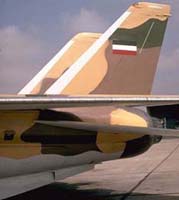 In 1974 and 1975 the Shah of Iran had ordered some 80 F-14As as the only foreign customer
for the Tomcat. The Iranian F-14s should counter the penetration and overflight of Soviet MiG-25
Foxbats over Iranian territory since the IIAF (Imperial Iranian Air Force) had no other
match for the MiG-25. Delivery of the F-14s lasted from early 1976 to July 1978 including some
270 AIM-54 Phoenix missiles. The 80th F-14 was not delivered due to the revolution in Iran and
overthrow of the Shah. From early 1979 onwards no more spare parts were delivered to the
new Islamic Republic of Iran and the Navy and Grumman technicians had to be replaced by foreign
technicians. A great set-back in the Iranian F-14 programm.
In 1974 and 1975 the Shah of Iran had ordered some 80 F-14As as the only foreign customer
for the Tomcat. The Iranian F-14s should counter the penetration and overflight of Soviet MiG-25
Foxbats over Iranian territory since the IIAF (Imperial Iranian Air Force) had no other
match for the MiG-25. Delivery of the F-14s lasted from early 1976 to July 1978 including some
270 AIM-54 Phoenix missiles. The 80th F-14 was not delivered due to the revolution in Iran and
overthrow of the Shah. From early 1979 onwards no more spare parts were delivered to the
new Islamic Republic of Iran and the Navy and Grumman technicians had to be replaced by foreign
technicians. A great set-back in the Iranian F-14 programm.
On 22 September 1980 Iraqi troops invaded Iran to occupy the region of the Schatt Al Arab
and some strategic islands in the Persian Gulf. These areas in Iran include some rich oil fields.
During the war, the Islamic Republic of Iran Air Force (IRIAF) was only able to keep a
mere seven to ten F-14s operational at any time. A lack of tires and brakes kept most of the
F-14s on the ground. Additionally, by 1986 Iran ran out of AIM-54 missiles and from then on the
only available armament were AIM-9 Sidewinder and AIM-7 Sparrow missiles. Therefore the F-14 was
often used in the airborne radar warning role covered sometimes by F-4Es or F-5Es.

Top of the page
Gulf War II: 1991, Free Kuwait
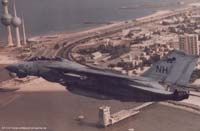 In 1991, half a year after Saddam Hussein's Iraqi troops invaded Kuwait, the Allied forces
started a massive air war against Iraq followed by a ground offensive to drive the Iraqi army out of
Kuwait and back into its own territory. The Allied air war was highly successful since soon
after the beginning of the air war the Allied fighters ruled in the skies over Iraq. A lot of
Iraqi fighter aircraft were flown to Iran to escape destruction, several Iraqi fighter aircraft were shot down
by Allied fighters. But not a lot of "MiG kills" happened, since the Iraqi Air Force
preferred to evade air combat because of an overwhelming superiority of Allied fighters which were
supported by airborne warning and control system (AWACS) aircraft from numerous countries.
In 1991, half a year after Saddam Hussein's Iraqi troops invaded Kuwait, the Allied forces
started a massive air war against Iraq followed by a ground offensive to drive the Iraqi army out of
Kuwait and back into its own territory. The Allied air war was highly successful since soon
after the beginning of the air war the Allied fighters ruled in the skies over Iraq. A lot of
Iraqi fighter aircraft were flown to Iran to escape destruction, several Iraqi fighter aircraft were shot down
by Allied fighters. But not a lot of "MiG kills" happened, since the Iraqi Air Force
preferred to evade air combat because of an overwhelming superiority of Allied fighters which were
supported by airborne warning and control system (AWACS) aircraft from numerous countries.
The F-14s' missions during the war were 1. both USN and USAF strike support, including both
sweep and combat air patrol (CAP), 2. Suppresion of Enemy Air Defence (SEAD) for USN and USAF
aircraft, 3. SCUD strike support, 4. Tactical Air Reconnaissance missions and 5. Fleet Air Defence
(FAD) and CAP. F-14 supported strikes were rarely engaged by enemy aircraft and achieved a 100%
success rate resulting in zero air-to-air loss of strike/SEAD aircraft. Coalition forces
specifically requested F-14s on numerous occasions for escort, High Value Unit CAP and protection
for forces during anti-ship operations.
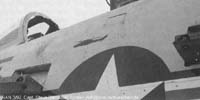
 The only air-victory of a Tomcat was the shooting down of an Iraqi Mil Mi-8 Hip
helicopter on February 6th, 1991. The helo came accross a pair of VF-1 Wolfpack F-14As
flying from USS Ranger in the Persian Gulf and was downed by the Commanding Officer of VF-1 CDR
Ron McElraft and Lt Stuart Broce with an AIM-9 Sidewinder missile.
No Grumman F-14 Tomcat earned a real MiG kill in this war. A rumor says that the
Iraqi fighter pilots preferred to reverse course and head for a save place when they were
detected by a powerful F-14 radar. If so, the Phoenix weapon system has been worth its money! The only air-victory of a Tomcat was the shooting down of an Iraqi Mil Mi-8 Hip
helicopter on February 6th, 1991. The helo came accross a pair of VF-1 Wolfpack F-14As
flying from USS Ranger in the Persian Gulf and was downed by the Commanding Officer of VF-1 CDR
Ron McElraft and Lt Stuart Broce with an AIM-9 Sidewinder missile.
No Grumman F-14 Tomcat earned a real MiG kill in this war. A rumor says that the
Iraqi fighter pilots preferred to reverse course and head for a save place when they were
detected by a powerful F-14 radar. If so, the Phoenix weapon system has been worth its money!
One VF-103 F-14B was lost on January 21st, 1991 with one crew rescued and one taken
prisoner of war.
F-14 squadrons in the Gulf War operations Desert Shield & Desert Strom:
(Source: US Navy)
|
VF-1 |
13 Jan 1991 - 19 Apr 1991 |
|
VF-2 |
13 Jan 1991 - 19 Apr 1991 |
|
VF-14 |
14 Sep 1990 - 12 Mar 1991 |
|
VF-21 |
05 Aug 1990 - 04 Nov 1990 |
|
VF-32 |
14 Sep 1990 - 12 Mar 1991 |
|
VF-41 |
14 Jan 1991 - 03 Apr 1991 |
|
VF-74 |
23 Oct 1990 - 09 Dec 1990,
06 Jan 1991 - 11 Mar 1991 |
|
VF-84 |
14 Jan 1991 - 20 Apr 1991 |
|
VF-102 |
15 Jan 1991 - 03 Apr 1991 |
|
VF-103 |
23 Oct 1990 - 09 Dec 1990,
06 Jan 1991 - 11 Mar 1991 |
|
VF-142 |
08 Aug 1990 – 24 Aug 1990 |
|
VF-143 |
08 Aug 1990 – 24 Aug 1990 |
|
VF-154 |
05 Aug 1990 - 04 Nov 1990 |
Today, as part of the U.S. presence in the Gulf the F-14s are enforcing the NO FLY zone
over Iraq and fly TARPS reconnaissance missions.

Top of the page
Gulf War III: Peace Keeping Missions
Since the end of the Gulf War the UN patrolled the skies of Iraq to control the No Fly
Zones in the north and south.
From time to time Iraq tried to provoke the UN and especially the USA. At the end of 1998 UN
weapon inspectors were again stopped and the US and the UK, finally at the end of their patience,
bomb Iraq in what became known as Operation Desert Fox. For several days Royal Air Force and US
fighters and bombers - plus US cruise missiles - destroyed targets. Recent intelligence information
revealed that the damage to Iraqi installations was greater than first thought.
After Operation Desert Fox the Iraq forbid any more weapons inspections and denied the
existence of the UN No Fly Zones.
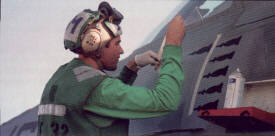 During the first days of 1999, 2 USAF F-15s and 4 US Navy F-14D (VF-213) were engaged by about
13 Iraqi MiGs and Mirage F.1s above the No Fly Zone in southern Iraq. In accordance with the UN
resolutions, both the F-15s and F-14s fired missiles at long distance at the Iraqi. No Iraqi
aircraft were hit, but one Iraqi fighter is said to have crashed on approach to its airbase
because of a lack of fuel.
During the first days of 1999, 2 USAF F-15s and 4 US Navy F-14D (VF-213) were engaged by about
13 Iraqi MiGs and Mirage F.1s above the No Fly Zone in southern Iraq. In accordance with the UN
resolutions, both the F-15s and F-14s fired missiles at long distance at the Iraqi. No Iraqi
aircraft were hit, but one Iraqi fighter is said to have crashed on approach to its airbase
because of a lack of fuel.
After this incident the UN continue to control the No Fly Zones, undisturbed by Saddam's forces
... eventually firing at Iraqi installations if provoked.

Top of the page
Missions over former Yugoslavia
 When the NATO decided to intervene in the war in what was once known as
Yugoslavia, fighter aircraft from various NATO countries flew reconnaissance and combat missions.
The U.S. Navy aircraft carriers with CVW-8 onboard were on station in the Adriatic Sea. In
support of the IFOR and SFOR troops in former Yugoslavia, F-14s from several squadrons flew
multi-role missions: Air-to-ground strikes against hostile targets (CAS, Close Air Support),
Forward Air Control (FAC(A)) and TARPS missions. In this conflict the Tomcats delivered life
laser-guided bombs for the first time for real. Also, flying from U.S. carriers, the F-14
represented the only U.S. photo reconnaissance aircraft in the Adriatic (except for the unmanned
recce drones).
When the NATO decided to intervene in the war in what was once known as
Yugoslavia, fighter aircraft from various NATO countries flew reconnaissance and combat missions.
The U.S. Navy aircraft carriers with CVW-8 onboard were on station in the Adriatic Sea. In
support of the IFOR and SFOR troops in former Yugoslavia, F-14s from several squadrons flew
multi-role missions: Air-to-ground strikes against hostile targets (CAS, Close Air Support),
Forward Air Control (FAC(A)) and TARPS missions. In this conflict the Tomcats delivered life
laser-guided bombs for the first time for real. Also, flying from U.S. carriers, the F-14
represented the only U.S. photo reconnaissance aircraft in the Adriatic (except for the unmanned
recce drones).
Kosovo Crisis: In March 1999, NATO decided to strike against Serbian forces due to
continuing ethnic expulsion and massacres against the Albanian people in Kosovo. To end
Yugoslavian terror NATO bombed Serbia for weeks day and night. The US send among others the
aircraft carrier USS Theodore Roosevelt which also ment launching F-14s. The role of the F-14s
was enemy fighter suppression, forward air control, aerial reconnaissance  and also precision
laser-guided air-to-ground attacks. When airstrikes ended, the role of the allied fighters was
changed to fly cover for the international KFOR troops who occupied Kosovo.
and also precision
laser-guided air-to-ground attacks. When airstrikes ended, the role of the allied fighters was
changed to fly cover for the international KFOR troops who occupied Kosovo.
Between 06 April and 09 June, CVW-8 fighters flew 4,270 total sorties and 3,055 combat sorties
with zero losses. The F-14s, EA-6Bs and F/A-18s of CVW-8 destroyed or damaged a total of 477
tactical targets and 88 fixed targets. Among others, VF-14 F-14s dropped some 350 laser-guided
bombs (a total of 350,000 lbs) and the Tophatters flew also FAC(A) missions for other
coalition strike aircraft.

Top of the page
Strike missions against terror
 On September 11, 2001, terrorists attacked the USA with hijacked airliners which they used as flying bombs. The unthinkable happened when the terrorists directed two airliners into the New York City World Trade Center towers, killing thousands of innocent people and damaging both towers so badly that both collapsed shortly thereafter. At the same time, another airliner was flown into the Pentagon in Washington, D.C.. Hundreds of people inside the building were killed, too. In a fourth airliner near Pittsburg, hijackers were heroically stopped by passengers when they fought against the terrorists onboard the flying airliner. However, this aircraft crashed killing all people onboard. The primary target of the terrorists, to crash the airliner into another city, failed.
On September 11, 2001, terrorists attacked the USA with hijacked airliners which they used as flying bombs. The unthinkable happened when the terrorists directed two airliners into the New York City World Trade Center towers, killing thousands of innocent people and damaging both towers so badly that both collapsed shortly thereafter. At the same time, another airliner was flown into the Pentagon in Washington, D.C.. Hundreds of people inside the building were killed, too. In a fourth airliner near Pittsburg, hijackers were heroically stopped by passengers when they fought against the terrorists onboard the flying airliner. However, this aircraft crashed killing all people onboard. The primary target of the terrorists, to crash the airliner into another city, failed.
Several thousand people were killed onboard the aircraft, in the buildings or on the streets around the buildings. Never before in modern history has such a terrorist act happened before. The whole world was shocked.
On Sept. 12, 2001 NATO implemented Article 5, which stated that an attack against a member in Europe or North America was an attack against them all.
The terrorists were identified as being a group around the Arab Osama Bin Ladin, living in Afghanistan under the protection of the ruling Taliban regime. In their fight against terrorism the USA were joined by all nations of the world (except Afghanistan and Iraq) - no matter what the country's religious orientation is. Weeks after the terrorist attacks, U.S. and British forces started a major series of strikes to battle the terrorists and their network, their infrastructure and weapons. On Oct. 7, 2002 aircraft carriers (CVN-65 with VF-14 & CVN-70 with VF-213) launched long-range, heavy loaded F-14 and medium-range F/A-18 strike fighters day and night while the Air Force sent long-range bombers deep into Afghanistan. Targets were terrorist bases, weapons and vehicles, training camps and Taliban military units. Additionally, the attacks were placed as a front-line pace maker for the so called "Northern Alliance". This group of anti-Taliban Afghans moved from northern Afghanistan down south in their long lasting fight against the Taliban regime. As in any war, the attacks caused also civilian casualties among the Afghan population, but as far as it is known these were limited to a small number.
On Oct. 9, 2002 VF-14 led the first long-range tactical air strike, flying over 1,700 miles round trip to Mazar-e Sharif, where Taliban aircraft were destroyed on the ground. Numerous strikes with precision guided ammunition followed from VF-14, VF-41, VF-102, VF-211 and VF-213.
The fight against world-wide terrorism has only just begun and the world faces a long period of insecurity until international terrororism is overcome.

Top of the page
USA go to war against Iraq
 Since Gulf War II the Iraqi government played games with the UN inspectors and failed to fully disarm and destroy the weapons as told by UN resolutions. This lasted for 12 years and nobody really seemed to care. In March 2003, the USA decided it was enough and went to war with Iraq without a UN resolution.
Since Gulf War II the Iraqi government played games with the UN inspectors and failed to fully disarm and destroy the weapons as told by UN resolutions. This lasted for 12 years and nobody really seemed to care. In March 2003, the USA decided it was enough and went to war with Iraq without a UN resolution.
F-14 Tomcats took part in the war as part of several Carrier Air Wings. The deputy commander of CVW-41 (USS Abraham Lincoln) stated, that even with the arrival of the F/A-18E, the F-14 remains "the platform of choice for precision targeting."
Five F-14 squadrons participated: VF-2, VF-31, VF-32, VF-211 and VF-213.
On other occasions during the Iraq war, F-14s were land based and supported special forces operations. Read more about it here (Extract from Inside The Navy)
Photos: VF-32, VF-74, VF-114, VF-213, Association of Naval Aviation, Tailhook Association,
Francois Therrien
|